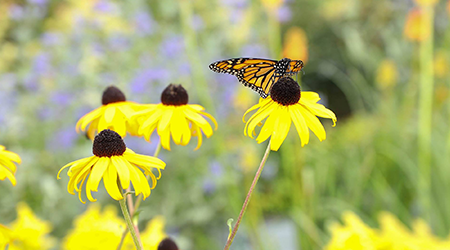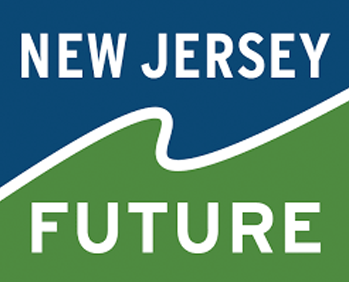
Environmental Benefits
In addition to the direct benefits green infrastructure can offer to developers and property owners, there are numerous benefits to the environment. These include improved water quality, energy conservation, habitat creation, and flood prevention, which are mutually beneficial to surrounding communities. Development is trending towards more resilient designs that allow for long-term planning in changing environments. Developers can not only garner public support through environmentally conscious designs, but they can also ensure the long-term viability and resilience of a project.

Green infrastructure can provide benefits to pollinators, such as butterflies and bees. These pollinators are essential components of our ecosystems. Image Credit: E&LP, 2020
Water Quality
Stormwater quality can be significantly improved by green infrastructure. Green infrastructure vegetation filters pollutants and reduces impacts to groundwater. Improved water quality helps reduce human impacts to local wildlife, which supports the natural systems surrounding built infrastructure.
Green infrastructure removes sediment, nutrients, and other pollution from runoff and can help increase groundwater reserves through infiltration. Certain types of green infrastructure can also reduce flooding damage to property and to streams. It can also be a cost-effective alternative to traditional water treatment infrastructure.
Flooding
Green infrastructure can reduce the effects of flooding in an area. Providing natural stormwater systems restores naturalistic buffers to coastal areas and manages runoff in developed areas. Flood control protects local ecosystems and mitigates impact from proposed impervious surfaces.
Recent catastrophic storm events have illustrated the value of resilient infrastructure planning and flood mitigation and prevention. State entities like the I-Bank offer revenue bonds to make loans to finance the construction of eligible environmental and transportation infrastructure projects for municipalities. The development community has felt the ripple effect of this rapidly changing landscape. Public-private partnerships to integrate flood prevention into redevelopment projects are becoming more regular. Green infrastructure is one of the key components in this aspect of effective resiliency planning.
Habitat Creation
If designed using native plant species, green infrastructure can provide habitat for a variety of beneficial animals such as birds and pollinators. Although developers may not immediately recognize the value of habitat creation, pollinators provide various “ecosystem services” essential for humans. Approximately one third of food production relies on animal pollination (EHP, 2015). Consequently, the agricultural economy relies heavily on pollinators. A study (Gallai et. al, 2009) approximated the economic value of pollinators to be $167 billion.

Mercer Meadows Environmental Education Basin in Mercer County, New Jersey. Image Credit: E&LP, 2020
Energy Conservation
Shade trees located around buildings help regulate outside temperature, slow wind, and reduce temperatures in warm weather. Likewise, green roofs help reduce the amount of solar heat that enters a building in summer and provide year-round insulation. These benefits have the effect of reducing overall energy usage, and consequently, the carbon footprint of the development. As noted earlier, energy conservation also makes these buildings more cost-effective to operate in the long term.

Green roofs, like the one on University of Pennsylvania’s Nursing School, can reduce heating and cooling needs by naturally regulating changes in temperature. Image Credit: Viridian Landscape Studio, 2020
